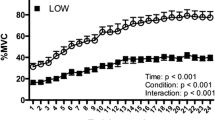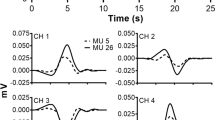Abstract.
Fifteen healthy, untrained male subjects (mean age ±SD, 22±5 years) were used to examine the plasticity of myosin heavy chain phenotype, size, oxidative capacity and capillarization of skeletal muscle fibre types with short-term electrical stimulation (ES). Ten subjects were electro-stimulated on both quadriceps muscles with a frequency of 45–60 Hz, with 12 s of stimulation followed by 8 s of recovery for a total of 30 min per day, 3 days per week for 6 weeks. The remaining five subjects served as controls. Two vastus lateralis muscle biopsy samples were removed from each subject before (week 0) and after (week 6) ES training. A standardized exercise test on a cycle ergometer was performed by each subject before and after the experimental period and several indicators of whole-body aerobic capacity were estimated. The so-called electromyographic threshold was also determined during the tests. Muscle biopsy samples were analysed by electrophoresis, immunohistochemistry and quantitative histochemistry. Myosin heavy chain (MHC) composition, muscle fibre type distribution, fibre areas, oxidative capacity and capillaries of each fibre type were estimated. Muscular changes with ES revealed an increase of fibres expressing MHC-IIA, and a decrease of fibres expressing MHC-IIX and MHC-I, as well as an increase of the oxidative capacity and mean number of capillaries of fast-twitch (type II) fibres with minimal muscle fibre hypertrophy. These adaptations seem related to a bi-directional transformation from both MHC isoforms I and IIX towards the MHC-IIA isoform. The aerobic performance and electromyographic variables at the whole-body level were not altered by ES. These results indicate that the particular short-term ES training protocol tested in the present study induces significant adaptations in histochemical and metabolic machineries of human skeletal muscle. The results also offer new perspectives for realistic applications of ES in various clinical situations and sport training.
Similar content being viewed by others
Author information
Authors and Affiliations
Additional information
Electronic Publication
Rights and permissions
About this article
Cite this article
Pérez, M., Lucia, .A., Rivero, .JL. et al. Effects of transcutaneous short-term electrical stimulation on M. vastus lateralis characteristics of healthy young men. Pflügers Arch - Eur J Physiol 443, 866–874 (2002). https://doi.org/10.1007/s00424-001-0769-6
Received:
Accepted:
Issue Date:
DOI: https://doi.org/10.1007/s00424-001-0769-6




